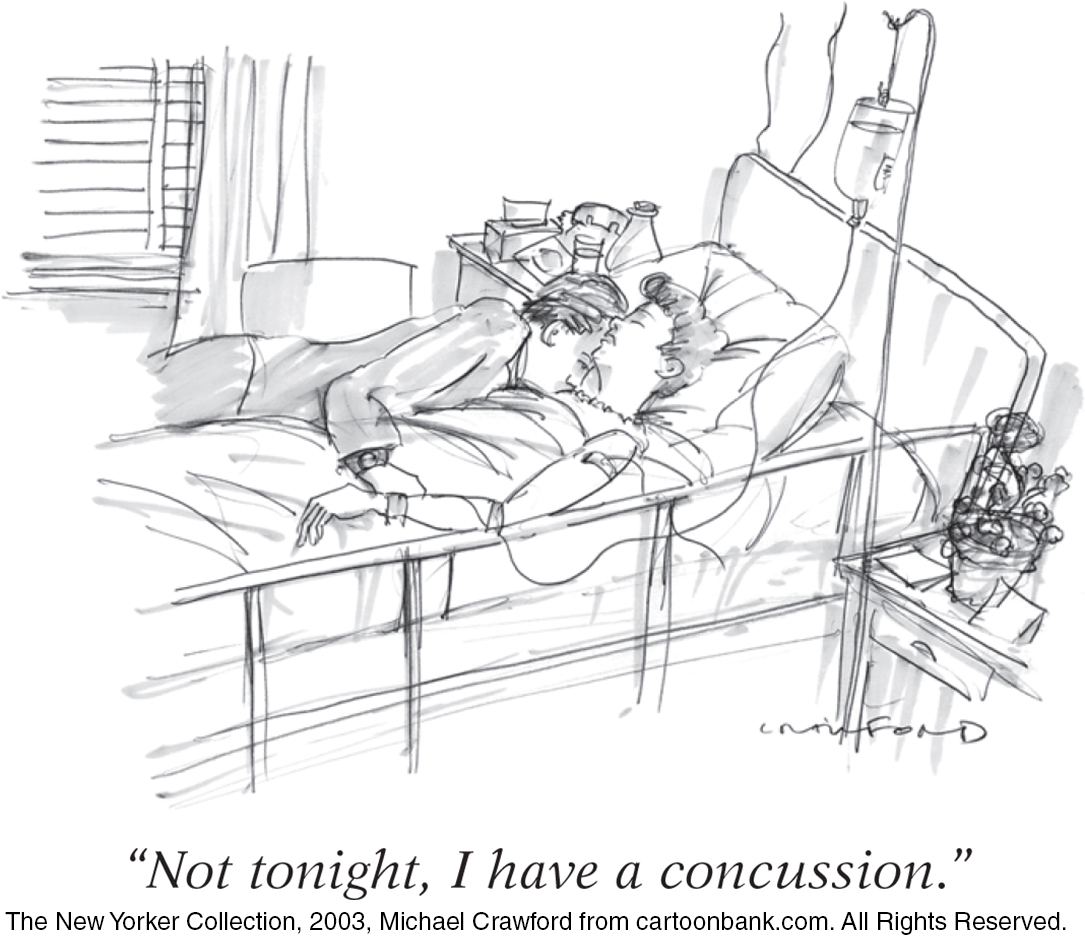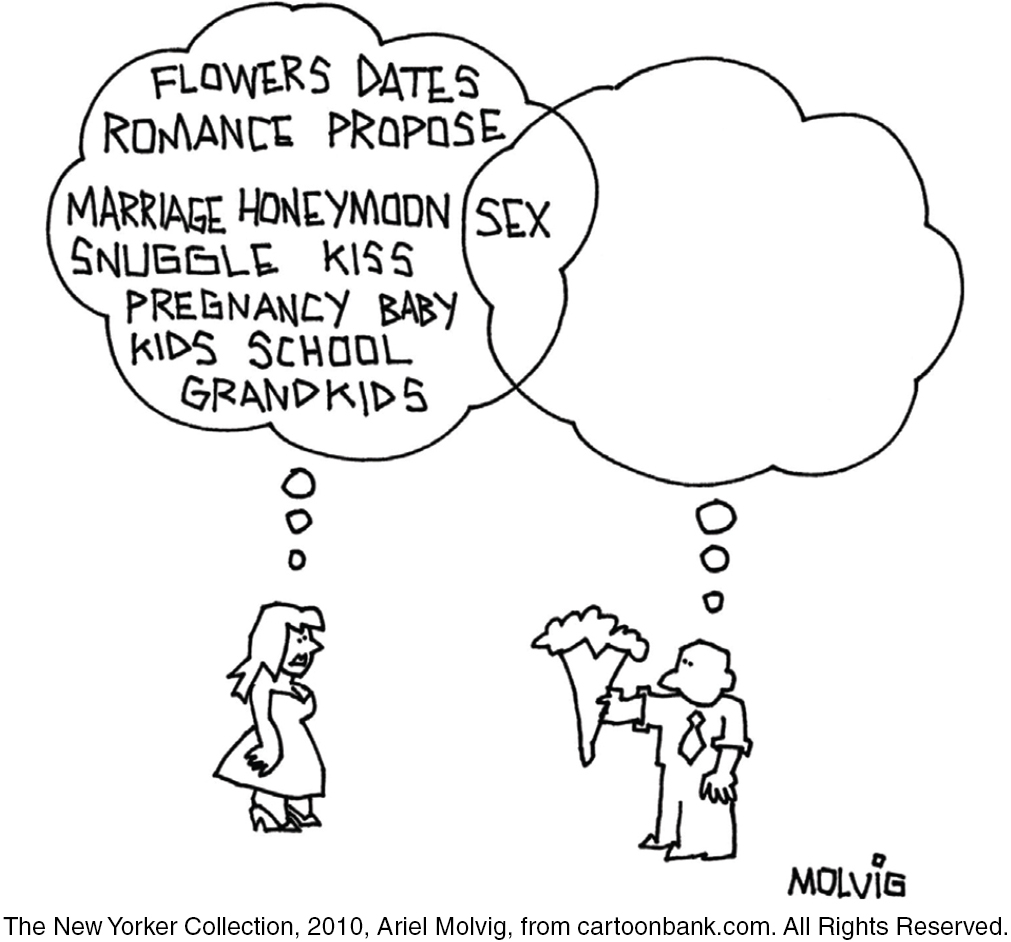15.4 An Evolutionary Explanation of Human Sexuality
15-
Having faced many similar challenges throughout history, males and females have adapted in similar ways: We eat the same foods, avoid the same predators, and perceive, learn, and remember similarly. It is only in those domains where we have faced differing adaptive challenges—
Male-Female Differences in Sexuality

And differ we do. Consider sex drives. Both men and women are sexually motivated, some women more so than many men. Yet, on average, who thinks more about sex? Masturbates more often? Initiates more sex? Views more pornography? The answers worldwide—
 To listen to experts discuss evolutionary psychology and sex differences, visit LaunchPad’s Video: Evolutionary Psychology and Sex Differences.
To listen to experts discuss evolutionary psychology and sex differences, visit LaunchPad’s Video: Evolutionary Psychology and Sex Differences.
And there are other sexuality differences between males and females (Hyde, 2005; Petersen & Hyde, 2010; Regan & Atkins, 2007). To see if you can predict some of these differences, take the quiz in TABLE 5.2.
Predict the Responses Researchers asked samples of U.S. adults whether they agreed or disagreed with the following statements. For each item below, give your best guess about the percentage who agreed with the statement.
| Statement | Percentage of males who agreed | Percentage of females who agreed |
| 1. If two people really like each other, it’s all right for them to have sex even if they’ve known each other for a very short time. | _____________ | _____________ |
| 2. I can imagine myself being comfortable and enjoying “casual” sex with different partners. | _____________ | _____________ |
| 3. Affection was the reason I first had intercourse. | _____________ | _____________ |
| 4. I think about sex every day, or several times a day. | _____________ | _____________ |
|
Sources: (1) Pryor et al., 2005; (2) Bailey et al., 2000; (3 and 4) Research from Laumann et al., 1994. |
||
(ANSWERS)
Compared with lesbians, gay men (like straight men) report more responsiveness to visual sexual stimuli, and more concern with their partner’s physical attractiveness (Bailey et al., 1994; Doyle, 2005; Schmitt, 2007; Sprecher et al., 2013). Gay male couples also report having sex more often than do lesbian couples (Peplau & Fingerhut, 2007). And they report more interest in uncommitted sex. Although men are roughly two-
“It’s not that gay men are oversexed; they are simply men whose male desires bounce off other male desires rather than off female desires.”
Steven Pinker, How the Mind Works, 1997
Natural Selection and Mating Preferences


Natural selection is nature selecting traits and appetites that contribute to survival and reproduction. Evolutionary psychologists use this principle to explain how men and women differ more in the bedroom than in the boardroom. Our natural yearnings, they say, are our genes’ way of reproducing themselves. “Humans are living fossils—
Why do women tend to be choosier than men when selecting sexual partners? Women have more at stake. To send her genes into the future, a woman must—
The data are in, say evolutionists: Men pair widely; women pair wisely. And what traits do straight men find desirable? Some, such as a woman’s smooth skin and youthful shape, cross place and time, and they convey health and fertility (Buss, 1994). Mating with such women might increase a man’s chances of sending his genes into the future. And sure enough, men feel most attracted to women whose waists (thanks to their genes or their surgeons) are roughly a third narrower than their hips—
There is a principle at work here, say evolutionary psychologists: Nature selects behaviors that increase the likelihood of sending one’s genes into the future. As mobile gene machines, we are designed to prefer whatever worked for our ancestors in their environments. They were genetically predisposed to act in ways that would leave grandchildren. Had they not been, we wouldn’t be here. As carriers of their genetic legacy, we are similarly predisposed.
Critiquing the Evolutionary Perspective
15-
Most psychologists agree that natural selection prepares us for survival and reproduction. But critics say there is a weakness in evolutionary psychology’s explanation of our mating preferences. Let’s consider how an evolutionary psychologist might explain the findings in a startling study (Clark & Hatfield, 1989), and how a critic might object.
Participants were approached by a “stranger” of the other sex (someone working for the experimenter). The stranger remarked, “I have been noticing you around campus. I find you to be very attractive,” and then sometimes asked, “Would you go to bed with me tonight?” What percentage of men and women do you think agreed to this offer? The evolutionary explanation of sexuality predicts that women will be choosier than men in selecting their sexual partners and will be less willing to hop in bed with a complete stranger. In fact, not a single woman agreed—
Or did it? Critics note that evolutionary psychologists start with an effect—

Other critics ask why we should try to explain today’s behavior based on decisions our distant ancestors made thousands of years ago. Don’t cultural expectations also bend the genders? Alice Eagly and Wendy Wood (1999; Eagly, 2009) point to the smaller behavioral differences between men and women in cultures with greater gender equality, for example. Such critics believe social learning theory offers a better, more immediate explanation for these results. Women learn social scripts—their culture’s guide to how people should act in certain situations. By watching and imitating others in their culture, they may learn that sexual encounters with strangers can be dangerous, and that casual sex may not offer much sexual pleasure (Conley, 2011). This alternative explanation of the study’s effects proposes that women react to sexual encounters in ways that their modern culture teaches them. Similarly, men are influenced by social scripts teaching the lesson that “real men” take advantage of every opportunity to have sex.
A third criticism focuses on the social consequences of accepting an evolutionary explanation. Are heterosexual men truly hard-
 To experience a demonstration and explanation of evolutionary psychology and mating preferences, visit LaunchPad’s PsychSim 6: Dating and Mating.
To experience a demonstration and explanation of evolutionary psychology and mating preferences, visit LaunchPad’s PsychSim 6: Dating and Mating.
Evolutionary psychologists agree that much of who we are is not hard-
Evolutionary psychologists also agree with their critics that some traits and behaviors, such as suicide, are hard to explain in terms of natural selection (Barash, 2012; Confer et al., 2010). But they ask us to remember evolutionary psychology’s scientific goal: to explain behaviors and mental traits by offering testable predictions using principles of natural selection. We can, for example, scientifically test hypotheses such as this: Do we tend to favor others to the extent that they share our genes or can later return our favors? (The answer is Yes.) They also remind us that studying how we came to be need not dictate how we ought to be. Understanding our tendencies can help us overcome them.
RETRIEVE IT
Question
How do evolutionary psychologists explain sex differences in sexuality?
Question
What are the three main criticisms of the evolutionary explanation of human sexuality?